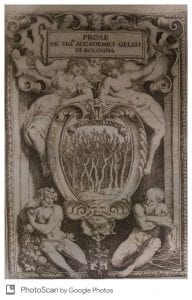New Acquisition: Sir Galahad: A Christmas Mystery by William Morris
Rumblings of thought during the latter portion of the nineteenth century in Great Britain insinuated the degradation and disintegration of integrity in design and manufacturing. The founders of the Arts and Crafts Movement, a response to this perceived degradation, were opponents of the Industrial Revolution who sought a return to the beauty and careful craftsmanship inherent to medieval and gothic design. The philosophical bases guiding the Arts and Crafts Movement were nestled in the works of A.W.N. Pugin and John Ruskin. Pugin criticized the British Industrial Revolution and, like Ruskin, idealized gothic/medieval techniques as key exemplars for workmanship and design. A fellow theorist of Ruskin, William Morris is credited with the founding of the British Arts and Crafts Movement. Morris shared in the philosophical leanings of Pugin and Ruskin; he condemned the inherent trend industrialism had wrought upon manufacturing – the creation of a severance between designer and manufacturer (Obniski, 2008). In reference to the effects of modern manufacturing processes, William Morris stated, “Apart from the desire to produce beautiful things, the leading passion of my life has been and is hatred of modern civilization” (Crawford, 1997).
The British Arts and Crafts Movement conceptualized the arts upon several principles. One principle, “the Unity of Art,” challenged any form of hierarchy in which certain art forms were privileged above others. Another principle, “Joy in Labor,” spoke to reuniting design and workmanship into the art of craftsmanship, where the laborer partook in a sense of joy in the creation of art (Crawford, 1997). In a preface to “The Nature of Gothic” by John Ruskin, printed by the Arts and Crafts-inspired Kelmscott Press of William Morris, Morris wrote, “The lesson which Ruskin here teaches us is that art is the expression of man’s pleasure in labor; that it is possible for man to rejoice in his work, for, strange as it may seem to us today, there have been times when he did rejoice in it” (Crawford, 1997). A third principle, “Design Reform,” inspired the creation of societies and associations that promoted the learning and development of craft and design (Crawford, 1997; Art Story Foundation, 2020).
William Morris wished not only for the beauty of manufactured items, but also for the utility. At the Great Exhibition of 1851 held in London, burgeoning Arts and Crafts enthusiasts widely recognized the necessity for the pairing of utility with fine craftsmanship (Art Story Foundation, 2020). Morris founded Morris and Co., a firm specializing in the creation of fine paintings, carvings, furniture, and metal works. The firm’s success in the rejection of industrialist practices and in the honoring of integrity in production showed “how beautiful handcrafted things could be and how they could be assembled with taste” (Thompson, 1996, p. 17).
Part of Morris’s monumental influence on Arts and Crafts aesthetic rested in his keen interest in typography and the craft of bookbinding (Art Story Foundation, 2020). He established the Kelmscott Press in 1891 in order to create “beautiful” books in what was to be a fervent revitalization of bygone techniques in typography, illumination, binding, and the selection of materials for production. The Works of Geoffrey Chaucer was perhaps one of the most revolutionary and exemplary publications of the Kelmscott Press. The work embodied the medievalist practices treasured by Arts and Crafts enthusiasts, from the elaborate borders to the ubiquitous intricate attention to detail. Quite famously, the Kelmscott Press developed the original typeface Troy, the iconic font of the Kelmscott Chaucer. Troy, set in gothic style, was not the only distinguished typeface attributed to the Kelmscott Press; William Morris collaborated with masterful typographer Sir Emery Walker to design the Roman-style typeface Golden used in the Kelmscott Press printing of The Golden Legend (Roylance, 1991; Peddie, 1915).
The influence of the British Arts and Crafts Movement on American craftsmanship was palpable in the late nineteenth century. The ideals of the British Arts and Crafts Movement trickled into the United States through journal and newspaper publications, and the influence of Morris and other Arts and Crafts enthusiasts was immeasurable (Obniski, 2008). Morris and Co. hosted showrooms exhibiting their productions in the cities of New York, Chicago, and Boston. Boston emerged as the epicenter of the American Arts and Crafts Movement with the founding of the American Society of Arts and Crafts in 1897. Soon after, the Guild of Arts and Crafts of New York was founded in 1900. Founded by four women, the Guild held a unique station in the representation of the contributions of women to the Arts and Crafts Movement. As the Arts and Crafts Movement continued to permeate the United States, private printing presses embodying the ideals of Morris, the Kelmscott Press, and other private presses of the British Arts and Crafts Movement, began to emerge and take hold (Thompson, 1996).
In addition to Morris’s success as a prolific artist and designer, he boasted a fine literary talent. One of his works, Sir Galahad: A Christmas Mystery, received acclaim and was notably printed by several private printing presses of the American Arts and Crafts Movement. University of Oregon Special Collections and University Archives (SCUA) recently acquired two printings of Sir Galahad: A Christmas Mystery by William Morris, one printed by Elston Press of New Rochelle, New York, in 1902, and the other printed by Blue Sky Press of Chicago in 1904.
The Elston Press edition of Sir Galahad: A Christmas Mystery was also bound by the Zaehnsdorf bindery, established by the renowned binder Joseph Zaehnsdorf in London in the mid-nineteenth century. The SCUA Unbound blog entry “Books as Art: Exploring Rare Zaehnsdorf Bindings” provides a history of the bindery. Sir Galahad: A Christmas Mystery is a poem composed by Morris that is a meld of romance and “medieval religious drama” (Stevenson & Hale, 2000, p. 383). The poem centers on the heroic tale of Sir Galahad, wrought with the requisite abundance of tests and trials of a hero’s journey (Stevenson & Hale, 2000).
The Elston Press was founded by Clarke Conwell and his wife, Helen Marguerite O’Kane, in 1900 in Manhattan, New York, prior to its relocation to New Rochelle, New York, in 1901. While Conwell managed the private press, O’Kane expertly designed the printings, an endeavor in which she greatly excelled. The books produced by the Elston Press adhered to impeccable standards; they were printed using handpress on homemade paper and bound by hand with boards, cloth, or vellum with ties (Thompson, 1996). The Elston Press printings primarily used red and black inks and extensively featured O’Kane’s decorative illuminations, often floral in nature. In the style of the Kelmscott Press, the Elston Press printed many of its publications in Chaucer typeface. O’Kane’s design of borders and initials are highly emulative of Morris’s work, while her illustrations, characterized by the absence of white space, are emulative of designer Burne-Jones. The Elston Press edition of Morris’s Sir Galahad: A Christmas Mystery was printed using a gothic typeface, and O’Kane’s design for the printing resembled Kelmscott Press features in border design, initials, and other stylistic elements (Thompson, 1996). The work is printed on handmade paper with black and red ink, a double-spread title page, and two full-page woodcut illustrations. Only 180 copies exist of the Elston Press edition of Sir Galahad: A Christmas Mystery (AbeBooks, n.d.).
The inception of the Blue Sky Press occurred in 1899 with its first publication, the magazine Blue Sky. Alfred G. Langworthy managed the operational matters of the press, while Thomas Wood Stevens, Alden Charles Noble, among others accounted for the design and collection of literature. The first printing of Blue Sky in 1899 used Jenson and Satanick typeface, while the second printing transitioned to Caslon typeface, which the Blue Sky Press used most widely. The printings of the Blue Sky Press are often simpler than those of the Elston Press and other presses derivative of Morris. Instead the designs reflect a marriage of the characteristics of the Arts and Crafts Movement, Art Nouveau, and the Aesthetic Movement (Thompson, 1996). The Blue Sky Press printed five hundred copies of Morris’s Sir Galahad: A Christmas Mystery on laid paper, and twenty-five copies on Japan vellum. The book is bound in dark green boards with matching dark green endpapers, complete with a gold-stamped title and a Morris border. The text is printed from hand lettered plates on one side of the page. The ink is varied in black and red, with a running title in red ink on each page. The printing most emulates the designs inherent to Morris and the Arts and Crafts Movement (Thompson, 1996).
The Elston Press 1902 edition of Sir Galahad: A Christmas Mystery by William Morris may be accessed for use from SCUA at https://alliance-primo.hosted.exlibrisgroup.com/permalink/f/hnf7s8/CP71310340850001451.
The Blue Sky Press 1904 edition of Sir Galahad: A Christmas Mystery by William Morris may be accessed for use from SCUA at https://alliance-primo.hosted.exlibrisgroup.com/permalink/f/hnf7s8/CP71150365580001451.
Sources
AbeBooks. (n.d.). Elston Press Rarity: Sir Galahad, a Christmas Mystery. https://abebooks.com
Art Story Foundation. (2020). The Arts and Crafts Movement. The Art Story. https://www.theartstory.org/movement/arts-and-crafts/history-and-concepts/
Crawford, A. (1997). Ideas and objects: The Arts and Crafts Movement in Britain. Design Issues, 13(1), 15-26. https://www.jstor.org/stable/1511584
Obniski, M. (2008). The Arts and Crafts Movement in America. The Metropolitan Museum of Art. https://www.metmuseum.org/toah/hd/acam/hd_acam.htm
Peddie, R. A. (1915). The history and practice of the art of printing. Journal of the Royal Society of Arts, 63(3242), 142-147. https://www.jstor.org/stable/41341892
Roylance, D. (1991). The art of the English book from William Morris to Eric Gill. The Princeton University Library Chronicle, 52(3), 367-383. https://www.jstor.org/stable/26404310
Stevenson, C. B., & Hale, V. (2000). Medieval drama and courtly romance in William Morris’ “Sir Galahad, a Christmas Mystery”. Victorian Poetry, 38(3), 383-391. http://www.jstor.com/stable/40002216
Thompson, S. O. (1996). American book design and William Morris. Oak Knoll Press and the British Library.
Written by Alexandra Mueller, Special Projects Archivist
















